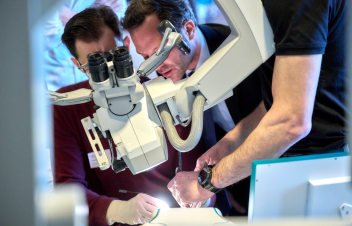Unveiling the Future: Inside a Center for Advanced Medical Learning and Simulation
- surgeonslab1
- Jun 21, 2024
- 4 min read

The progress in medical education has brought changes in the training paradigm of health workers from old-fashioned teaching methods to modern approaches. Leading this revolution is the Center for Advanced Medical Learning and Simulation (CAMLS), which trains future doctors and other medical practitioners to practice in a real yet safe environment. This paper aims to describe the opportunities that are provided by these centers and to reveal the essential role of such structural solutions in forming further evolution of medical training.
The Vision of Advanced Medical Learning
Traditionally, medical education involved extensive reliance on books, lectures, and little practice. However, this method was largely more theoretical in nature and did not provide much of the kind of experience and exposure required to acquire important skills necessary for neurointerventional procedures. This change to more simulator-based learning is a landmark change in medical training as it brings a fresh and very practical means of learning.
Core Components of a Simulation Center
Any building of a typical simulation center can be described as a facility with a modern architectural vision and high-tech. These are the modern training facilities such as the training rooms, operating theatres, and patient care units, whereby the respective technology utilized is similar to that in the health care facilities. This center is based on state-of-the-art technology, including virtual reality systems and high-fidelity manikins that respond like real-life humans. They are utilized in teaching in that they are incorporated into the coursework, through which students engage in role modeling exercises, emergency simulations, surgical equipment management, and the sharpening of their skills in a relatively more restricted environment.
Within CAMLS, the curriculum is well-planned in a way that leverages the benefits of simulation. They will cover all types of activities, from simple check-ups to operations carried out on patients, thus making training very thorough. This is a great plus for acquiring practical experience, which helps to apply theoretical knowledge in practice.
Inside the Simulation Experience
Simulation-based learning is meant to simulate real-life clinically and as accurately as possible. Every simulation is preceded by careful preparation to correspond to certain medical conditions. In the last structure of the context, the students participate in a schooled or taught simulation in which he or she deals with a dynamic environment. It subsumes many medical disciplines, which means that doctors of different specialties have to cooperate with each other and take care of patients comprehensively.
By employing modern manikins and VR products, the simulations do not differ much from real-life situations, but learners fail without endangering the patients’ lives. This steady though simulation environment is instrumental in increasing confidence and performance in the medical practitioners.
Impact on Medical Professionals and Patient Care
Simulated training centers play a vital role in the development of clinical competencies and problem-solving skills in different cases among these healthcare specialists. Given that these centers afford healthcare providers ample opportunity to practice and receive feedback in real-time, these centers increase the competence of such professionals considerably. This enhancement in skill level has a direct positive correlation with the customers, who are patients, and this is due to the fact that skilled personnel are able to diagnose and treat various ailments in a much better way than less skilled ones.
Furthermore, lifelong learning belongs to the fields that are of crucial interest to the Center for Advanced Medical Learning and Simulation. They have a mandate of maintaining the learning process of the healthcare providers, which in turn helps providers to update their knowledge and practice on the latest developments in the field of medicine. Such commitment is quite effective in ensuring that high quality of care and the safety of the patients are observed.
Challenges and Considerations
Accessibility and Cost
There is one big problem associated with the accessibility of CAMLS or other centers for advanced medical learning and simulation. These centers need a considerable sum of money to be invested in their development and running. Some of the technologies, such as high-fidelity manikins and VR systems, are relatively expensive. Also, the setup of these technologies with specially designed rooms for training and technicians to support the equipment are other factors that contribute to the cost.
Integration into Existing Curriculum
Despite the fact that information technology forms the backbone of most simulation centers, they also pose unique problems. The technological change is at a very fast pace, which indicates that simulation centers have to acquire new technology and software frequently. This can be a little expensive and very time-consuming. In addition, one can experience technical problems and failures, which are also able to interfere with training sessions and become learning barriers.
Conclusion
In summary, the Centers for Advanced Medical Learning and Simulation represent a groundbreaking advancement in medical education. By providing realistic, hands-on training for neurointerventional procedures in a safe environment, these centers enhance the skills and confidence of medical professionals, ultimately leading to improved patient care.
Looking ahead, the expansion and evolution of these centers hold great promise for the future of medicine, ensuring that healthcare providers are well-equipped to meet the challenges of an ever-changing medical landscape.







